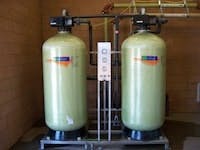In January 2009, Pioneer Industries Inc. contacted AdEdge Water Technologies LLC to provide an arsenic, iron, fluoride and TDS removal system for the village of Floyd, N.M. The water system serves the community of 150 residents.
Project Background
The existing water system consisted of two wells feeding into a distribution system with a maximum capacity of 62 gal per minute (gpm). The raw water has an arsenic level of 11 ppb, which is higher than the U.S. Environmental Protection Agency (EPA) maximum contaminant level (MCL) of 10 ppb. The raw water also has an iron level of 2.5 mg/L, a fluoride level of 4.12 mg/L and a TDS level of 789 mg/L, all greater than the EPA MCLs of 0.3 mg/L, 4 mg/L and 500 mg/L respectively.
Treatment Solution
The AdEdge treatment approach features a skid-mounted AD26 oxidation/filtration system for arsenic and iron removal and a reverse osmosis (RO) system for arsenic, fluoride and TDS removal. Water is pumped from the well and treated with a continuous feed of sodium hypochlorite via the AdEdge ADIN chemical feed system to optimize the removal of arsenic and to oxidize the AD26 media. The water then processes through the AD26 arsenic and iron removal system consisting of two 30-in. diameter vessels. Each vessel contains 14 cu ft of the AD26 manganese dioxide media. Following the AD26 treatment system, the water is split into two streams.
The first stream is rated for 12 gpm and is directed around the RO system to blend with the RO product water. The second stream is rated for 50 gpm and is treated with sodium metabisulfite via an antioxidant module to prevent damage to the RO membrane from the sodium hypochlorite. The second stream is also treated by a scale inhibitor that is injected into the water prior to the RO system to minimize mineral scaling and to optimize performance.
The water is then treated by the reverse osmosis unit by nine membranes. Within the RO membrane arrays, the filtered water is split into two streams: product water and concentrate. The RO product water is blended with the AD26 bypass stream and directed to the storage tank for distribution. The concentrate is recycled through the RO and then disposed of. The treated water moves to a 169,000-gal storage tank before going to distribution.
The system is equipped with a programmable logic controller to perform automated functions of the system including chemical feed dosing, backwashing, alarms and controlling flow. Backwashing of the AD26 treatment system occurs every two to three days to remove any suspended solids that accumulated in the bed and to hydraulically fluff the bed to prevent channeling.
Successful Results
The system was installed and began operating in July 2010. Testing of the treated water shows arsenic, iron, fluoride and TDS all at non-detectable levels.
Richard J. Cavagnaro is marketing coordinator for AdEdge Water Technologies. Cavagnaro can be reached at [email protected] or 678.835.0052.


